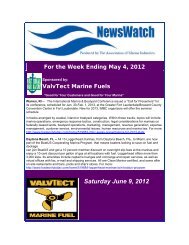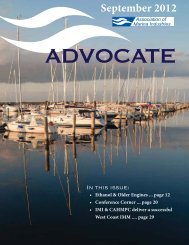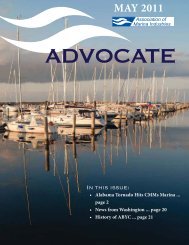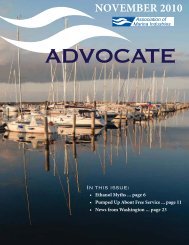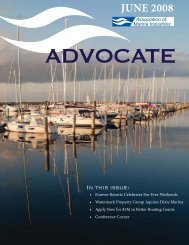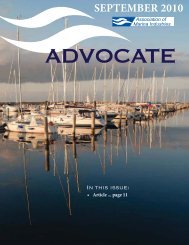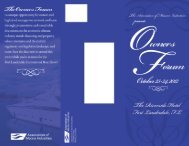SEPTEMBER 2009 - Association of Marina Industries
SEPTEMBER 2009 - Association of Marina Industries
SEPTEMBER 2009 - Association of Marina Industries
You also want an ePaper? Increase the reach of your titles
YUMPU automatically turns print PDFs into web optimized ePapers that Google loves.
Technical Advice<br />
From Bob Adriance<br />
E-10 in Winter: Recommendations on<br />
Storing Ethanol-Enhanced Gasoline<br />
Now that ethanol is a fact <strong>of</strong> life in many parts <strong>of</strong> the country,<br />
a test is being give every winter when boats are prepared<br />
for seasonal lay-up. One <strong>of</strong> the unfortunate properties<br />
<strong>of</strong> ethanol is its ability to attract and absorb water.<br />
Ethanol-enhanced gasoline can absorb roughly10 times as<br />
much water as MTBE, the gasoline it is replacing, and still<br />
burn safely through the engine. But if ethanol becomes<br />
saturated, which can happen when it sits for long periods,<br />
the ethanol separates from the gasoline, forming two separate<br />
solutions. This is called phase separation and it’s bad<br />
news for the engine. An engine won’t run on the (watersoaked)<br />
ethanol solution, which sinks to the bottom <strong>of</strong> the<br />
tank and is highly corrosive.<br />
happen, the highly corrosive ethanol/water mixture would<br />
settle to the bottom <strong>of</strong> the tank and would remain there<br />
even after fresh fuel was added in the spring.<br />
There is no quick fix. When MTBE became saturated with<br />
water, it remained chemically bonded to the gasoline—<br />
MTBE doesn’t phase separate—and a water separator could<br />
eliminate the excess moisture. With ethanol-enhanced<br />
gasoline, however, once phase separation occurs, additives,<br />
water separators, and adding fresh gasoline can’t help; the<br />
only remedy is to have gasoline/ethanol/water pumped<br />
from the tank.<br />
While all <strong>of</strong> this may sound discouraging, the good news<br />
is that E-10 has been a fact <strong>of</strong> life in certain areas <strong>of</strong> the<br />
Midwest for over a decade and there have been relatively<br />
few problems. Seaworthy talked to several marina operators,<br />
surveyors and boat owners in the Chicago area who<br />
had the same reaction to ethanol: “It’s no big deal.”<br />
No big deal How can E-10, which attracts moisture and<br />
can fall apart, be expected to survive the winter With any<br />
fuel that will be sitting for a long time, it is important to<br />
add stabilizer—an antioxidant—to extend the life <strong>of</strong> the<br />
fuel. (E-10 and gasoline with MTBE have the same shelflife—roughly<br />
a year.) What a stabilizer won’t do, however,<br />
is prevent phase separation. Just how you do that is subject<br />
to some debate. Several sources, including one prominent<br />
engine manufacturer, recommend running the tank down<br />
to almost empty and then adding stabilizer. The following<br />
spring, the tank can be refilled with fresh gasoline. Lew<br />
Gibbs, a senior engineering consultant at Chevron, worries<br />
that leaving a few gallons <strong>of</strong> gasoline might attract enough<br />
condensation to cause phase separation. If that were to<br />
9<br />
Gibbs said his first choice would be to completely empty<br />
the tank when the boat is laid up and then refill it the following<br />
spring with fresh gasoline. No ethanol = no ethanol-related<br />
problems. Unfortunately, completely emptying<br />
a built-in tank safely is nearly impossible. His next choice,<br />
one that’s more practical, is to top <strong>of</strong>f the tank to 95% full<br />
(to allow for expansion). A tank that’s almost full reduces<br />
the flow <strong>of</strong> air into and out <strong>of</strong> the vent, which reduces condensation<br />
on tank walls. Any condensation that does form<br />
will be absorbed by the gasoline. (Note that the National<br />
Fire Protection <strong>Association</strong> [NFPA] also requires tanks to<br />
be topped <strong>of</strong>f to minimize explosive vapors.)<br />
Gibbs said the worst choice, which was confirmed by marina<br />
owners in the Midwest, is to leave the tank half-full over<br />
the winter. Jerry Metzger, the general manager <strong>of</strong> Chicago<br />
Harbor’s nine marinas, said phase separation problems<br />
typically occurred when boats had been stored over the<br />
winter with tanks that were a quarter to half full. The partially-filled<br />
tanks breathe more and attract larger amounts<br />
<strong>of</strong> moisture. Metzger says boaters in the area have learned<br />
to fill the tanks before the boat is laid up for the winter.<br />
Note, however, that phase separation can occur anytime<br />
E-10 sits for a long time. On Long Island Sound, which has<br />
been using ethanol-enhanced gasoline for the past couple<br />
<strong>of</strong> seasons, Mitch Kramer at TowBoatU.S. Oyster Bay said<br />
they haven’t had any problems with their own boats, which<br />
are used every day. Kramer says the problems now on Long<br />
Technical Advice Continued on Page 9



